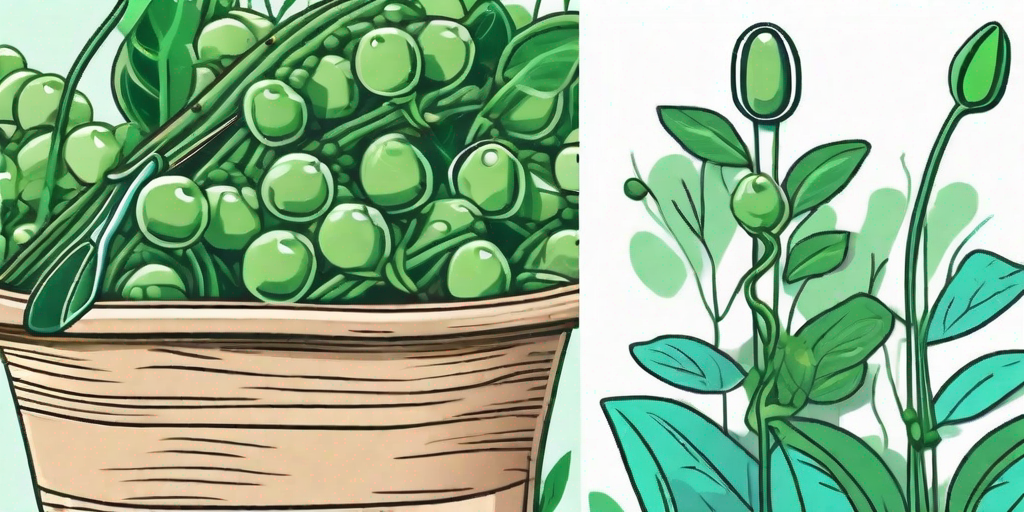
Peas, those little green orbs of delight, are a staple in many a garden and kitchen. They're versatile, nutritious, and let's face it, pretty darn cute. But how does one go from pea plant to pea pod to plate? Well, dear reader, that's where this guide comes in. We're going to delve into the world of pea harvesting and give you all the tips and tricks you need to pick peas like a pro.
Understanding the Pea Plant
Before we dive into the nitty-gritty of pea picking, it's important to understand the plant itself. Pea plants are a type of legume, which means they have the magical ability to take nitrogen from the air and convert it into a form that plants can use. This makes them a great addition to any garden, as they can help improve soil fertility.
Pea plants are also climbers, which means they love to reach for the sky. This can make them a bit of a handful to manage, but with the right support (like a trellis or some stakes), they can be kept under control.
The Life Cycle of a Pea Plant
Pea plants go through several stages before they're ready to harvest. They start as seeds, which germinate and grow into seedlings. These seedlings then develop into mature plants, which produce flowers. These flowers are then pollinated (either by insects or the wind), which leads to the formation of pea pods.
The pea pods are where the magic happens. Each pod contains several peas, which mature over time. Once the peas have reached the right size and firmness, they're ready to be harvested.
When to Harvest Peas
Knowing when to harvest your peas is crucial. Harvest too early, and your peas will be small and underdeveloped. Harvest too late, and your peas will be tough and starchy. The key is to find that sweet spot where the peas are just right.
Generally, peas are ready to harvest about 60 to 70 days after planting. However, the exact timing can vary depending on the variety of pea and the growing conditions. The best way to tell if your peas are ready is to feel the pods. They should be plump and firm, but not hard. The peas inside should be visible through the pod, but not bulging out.
Harvesting Tips and Tricks
When it comes to harvesting peas, there are a few tips and tricks that can make the process easier and more efficient. First, always harvest in the morning. This is when the peas are at their sweetest, as the cool night temperatures slow down the conversion of sugars to starch.
Second, be gentle. Pea plants are delicate, and rough handling can damage the plant and reduce future yields. When picking, hold the pea pod in one hand and the stem in the other, and gently twist until the pod comes off.
Storing and Preserving Your Peas
Once you've harvested your peas, it's time to think about storage. Fresh peas are best eaten immediately, but if you have a bumper crop, you might need to preserve some for later.
Peas can be stored in the fridge for up to a week, but for longer-term storage, freezing is the way to go. To freeze peas, blanch them in boiling water for one minute, then plunge them into ice water to stop the cooking process. Drain the peas, then spread them out on a baking sheet and freeze until solid. Once frozen, transfer the peas to a freezer bag or container.
Pea Recipes
Now that you've harvested and stored your peas, it's time to enjoy them! Peas are incredibly versatile and can be used in a wide range of dishes, from salads and soups to stir-fries and stews.
For a simple and delicious pea dish, try sautéing fresh peas with a little butter, garlic, and mint. Or for something a bit more substantial, whip up a pea and ham soup or a pea and prawn risotto.
Frequently Asked Questions
Can I eat the pea pods?
Yes, you can! The pods of some varieties of peas, like sugar snap peas and snow peas, are tender and delicious. Just make sure to remove the stringy seam before eating.
What if my peas are tough and starchy?
If your peas are tough and starchy, it's likely that they were harvested too late. Next time, try harvesting a bit earlier when the pods are plump but not bulging.
Can I save some peas for planting next year?
Absolutely! Just let some of your pea pods mature fully on the plant until they're brown and dry. Then, shell the peas and store them in a cool, dry place until next planting season.
And there you have it, a comprehensive guide to harvesting peas like a pro. With these tips and tricks, you'll be a pea-picking master in no time. So get out there and start harvesting!











